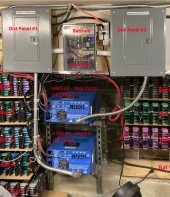I agree this is a valid approach - e.g. the issue with buying things over (long) times (years) is that models/availability can change.
However, it is possible to have multiple, unrelated inverters. It just takes extra effort to wire into the home for consumption. I have 2 x 12,000w AIMS that are independent and they power completely different sets of circuits. It did take a good understanding of power on each circuit to kind of 'balance things'.
View attachment 132824
And in fact, after 4+ years and 25,000hrs of operation - AIMS #1 has died and AIMS support is not being helpful / ignoring my requests for replacement parts. However, since these inverters are 'separate' I can replace AIMS #1 with a different model if I don't get help from AIMS soon.



